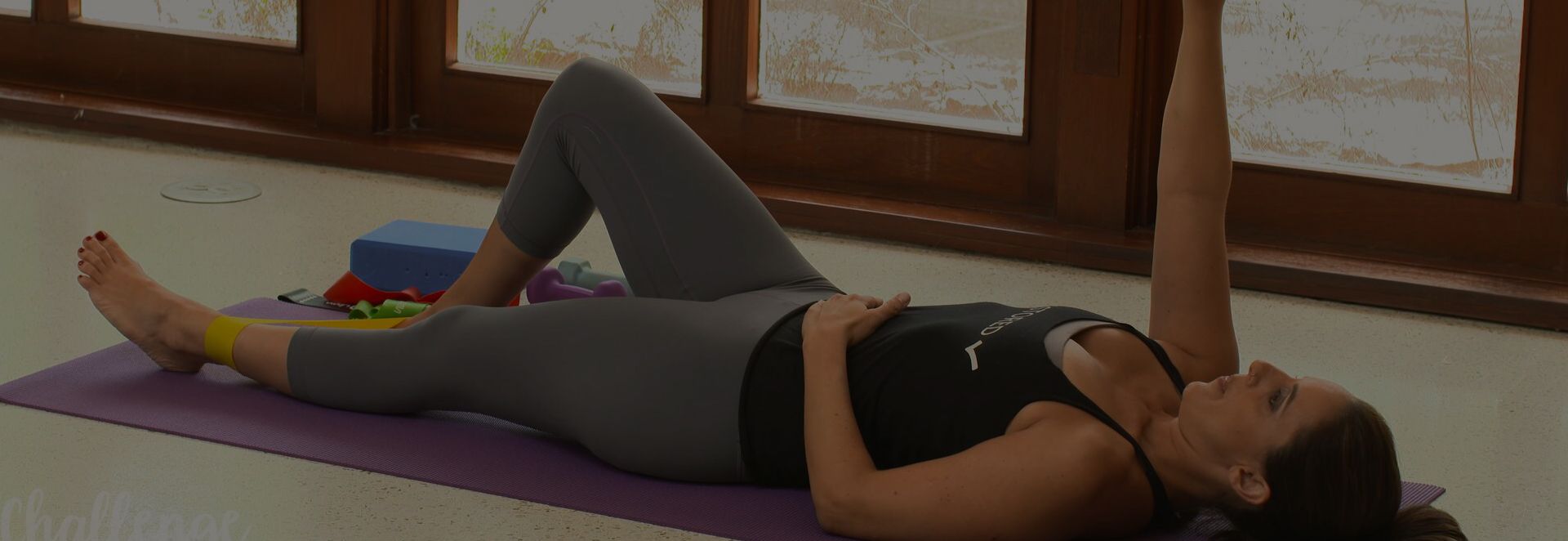Resources
- Understanding Pelvic Organ Prolapse: What You Need to Know
- Prolapse After Hysterectomy: A Comprehensive Guide to Risks and Prevention
- Can You Have Intercourse With Prolapsed Uterus?
- Understanding Prolapse After Childbirth
- The Intersection of Prolapse & Weightlifting: What Athletes Should Know
- Hip Mobility and Prolapse: Connection & Exercises to Mitigate Prolapse Symptoms
- Effective Exercises for Relief and Recovery from Prolapsed Uterus
- Uterine Prolapse
- Rectal Prolapse
- How Common is a Prolapse After a Hysterectomy?
- How to Stop a Prolapse from Getting Worse
- Prolapse Surgery
- What is Cystocele?
- Rectocele Repair | Surgery or Exercise
- Rectocele Symptoms : The Signs of Rectocele Dysfunction

FREE video support with Lauren Ohayon
*No spam, just quality
content and support
Resources
- Understanding Pelvic Organ Prolapse: What You Need to Know
- Prolapse After Hysterectomy: A Comprehensive Guide to Risks and Prevention
- Can You Have Intercourse With Prolapsed Uterus?
- Understanding Prolapse After Childbirth
- The Intersection of Prolapse & Weightlifting: What Athletes Should Know
- Hip Mobility and Prolapse: Connection & Exercises to Mitigate Prolapse Symptoms
- Effective Exercises for Relief and Recovery from Prolapsed Uterus
- Uterine Prolapse
- Rectal Prolapse
- How Common is a Prolapse After a Hysterectomy?
- How to Stop a Prolapse from Getting Worse
- Prolapse Surgery
- What is Cystocele?
- Rectocele Repair | Surgery or Exercise
- Rectocele Symptoms : The Signs of Rectocele Dysfunction
I Healed My Prolapse: How Targeted Exercises Helped Me
By Lauren Ohayon 02/06/2024
4 Min Read
If you’ve recently been diagnosed with pelvic organ prolapse, it’s natural to be overwhelmed by a mix of shock, confusion, fear and even devastation. This article will share some personal journeys of treating and managing prolapse through targeted exercises and other natural methods.
Let’s start with a note of encouragement: Pelvic organ prolapse can be an intense diagnosis to receive. There are many women who feel like there’s not much they can do. But at RYC®, we’ve seen time and time again that with time and effort, change happens, “Within the first 2 weeks, my prolapse symptoms were gone. Within 12 weeks, I felt strong again. Within 6 months, my doctor confirmed I NO LONGER HAVE A PROLAPSE AND I was back to running, picking up my kids and all other activities.” –Christina Freeman
Table of Contents
How do I know if I have a prolapse?
While people are slowly beginning to speak up about some kinds of pelvic floor dysfunction like stress urinary incontinence (“sneeze pee”), pelvic organ prolapse is much less well-known. Pelvic organ prolapse, or POP for short, describes a condition where one or more organs in the pelvic bowl have moved out of place.
There are five primary types of pelvic organ prolapse:
- Bladder prolapse- Cystocele
- Rectum prolapse- Rectocele
- Uterine Prolapse
- Vaginal Vault Prolapse-only applies to those who have had hysterectomies
- Small Intestine Prolapse- Enterocele
The exact causes of POP are varied, but major risk factors include:
- Labor and vaginal delivery
- Trauma or injury to the pelvic floor muscles
- Chronic constipation
- High body weight
- Connective tissue disorder
This does not mean that if you’re chronically constipated, you’ll have a prolapse. What it does mean is that if you’re chronically constipated, and you have some of the symptoms below, you might want to get evaluated.
All the mentioned risk factors share one common feature: increased pressure inside your abdomen. Think of your core system, including your pelvic floor and diaphragm, as a balloon. When you squeeze the top of the balloon (like holding your breath) or compress the middle (as if you’re sucking in your stomach), the bottom of the balloon pushes outward and downward. This simplified analogy helps illustrate intra-abdominal pressure, which is a natural part of your breath system and essential when used correctly. However, if you’re already tense in your core or pelvic floor, excessive downward pressure can worsen conditions like prolapse.
Symptoms you may experience:
- A heavy, pulling or dragging sensation in the pelvic floor
- Feeling of heaviness in the lower abdomen
- Pain or discomfort during intercourse
- Difficulty with urination, including incomplete bladder emptying or urine leakage
- Constipation
- Back pain
- Visible or palpable bulge
Here’s how Erin describes her initial experience with prolapse:
“I was devastated when I was diagnosed with a stage 2 cystocele after the birth of my second child. Over a year postpartum, I was still unable to go for a walk around the block without feeling it. I sunk into depression and wondered if my bladder would fall out every time I lifted my baby.”
The good news is that Erin successfully used exercise to recover: “The change from start to finish, and now over a year later, has been amazing. My baby is now a 25+ pound toddler. I am back to pre-baby activity levels: running, cycling, rowing, and hiking — some of which involves carrying the toddler. I cannot remember the last time I felt any symptoms of my cystocele — I have had none since completing RYC®. This program truly gave me my life back and I am forever grateful.”
There are several treatment modalities available for POP: targeted exercises, pessaries, and surgical options are all appropriate depending on the severity of the prolapse. I’m going to focus on the impact of targeted exercises in this article, since that’s our focus in Restore Your Core®.

What happens when I get diagnosed with pelvic organ prolapse?
Usually, a diagnosis of pelvic organ prolapse can be made with a standard pelvic exam
The distinguishing feature of prolapse, as opposed to other pelvic floor dysfunctions, is that the displaced organ usually creates a visible or palpable bump or bulge in the vaginal canal, or in the rectum or anus, depending on the type of prolapse you have. Ideally, your doctor will assess you both lying down and standing up, since gravity can affect how a prolapse looks and feels.
The experience of receiving a POP diagnosis can be emotionally difficult
We see this all the time in the Restore Your Core® Facebook community: people use words like “devastated,” “doomed,” and “broken” to describe how they feel with prolapse. Many people with prolapse have drastically reduced their physical activity due to the fear of making their prolapses worse, which has a significant impact on their mental well-being. It’s important to recognize that everyone experiences a decline in physical abilities at some point in life, but that doesn’t mean it’s not challenging when it happens to you, especially if you’re raising small children or managing a demanding career, or both.
The inability to perform simple tasks like chasing after your toddler or picking up your baby can greatly affect your daily life. Seeking mental health support as part of your healing process may be advisable, in addition to physical treatment options. Many people also find that a supportive group of peers can be a huge aid in the healing process.
When you have the support of a solid team, whether that’s your team of providers, your online community, or your local family and friends, the healing journey becomes one you’re not taking alone. Everyone’s journey is different. Watching other people take their own positive steps helps you stay on your path, too.
One of our community members talks about how important mindset is to this journey, “I have learnt how to listen to my body, the importance of building strength and tolerance over time, of how to tune in and adapt rather than push through. I have learnt to not give up and spiral into negative thoughts – when I did have leaking episodes or pain in the beginning. I honestly could hear Lauren Ohayon’s voice in my head telling me, ‘this is how you feel today, it does not mean you’ll feel like this forever, or even tomorrow.’” There is hope.
What are the treatment options?
Depending on the severity or grade of the prolapse(s), you may be offered different options for treatment:
Targeted exercises
Targeted exercises, like what you’ll do with a physical therapist, can help you work on the underlying patterns and muscular imbalances that may be part of the picture. The Restore Your Core® program takes a comprehensive and holistic approach by addressing various factors that affect pelvic floor function. Many people find resolution of their symptoms with exercise alone, but it takes time.
Vaginal pessary
A pessary is a small device, often shaped like a ring, that is inserted into the vagina to provide support to the pelvic organs. It should feel unobtrusive and helps particularly with the feeling of “something falling out” that many people with prolapse experience. For many people, a pessary works like crutches: helpful as part of the healing journey.
Surgery
There are different kinds of surgical options for severe prolapses; many are effective and the medical community continues to improve the technologies involved. Be sure to ask your doctor what techniques they use if surgery is recommended for your prolapse. Do your research and ask around for others’ experiences with the surgeon you’re working with, just as you would for any other procedure. It’s important to use prehab and rehab exercises before and after your surgery in order to ensure the best possible outcomes.
What to expect from your healing journey
The journey of healing from any injury will always include what feels like two steps forward and three steps backward. However, those steps backward are not actually “backward” steps and they are incredibly important to the healing journey.
Our bodies are always reacting to the inputs that we are providing, and if our bodies are feeling a new input or are suspicious about an input, we can expect to feel sensations in response to that input. That heightened sensation can come in the form of pain, discomfort, or an increase in symptoms. It can be incredibly disheartening and we can start to believe that we have undone our progress or made our prolapse worse, when in fact this is all a normal part of the healing journey. You can expect that your healing will take time. You can expect that your body will be different–any time we get injured, this is true. It’s not about a destination; healing is about the journey.
Felicitas Rapp describes her healing journey here:
“I’m 14 months postpartum, had a grade 3 bladder prolapse and struggled a lot with pain in various joints… due to the pandemics, I did an online rehab course, where we were supposed to do jumping jacks in week 3. Didn’t feel right. Then I found RYC®. I started doing it and my symptoms started to get better. I could bend over again, I could walk longer without that “falling out” feeling, and I learned SO MUCH about my body!! Now I run with my little one on the street and jump gently on the trampoline—it feels so good!”

Targeted Exercises for Prolapse
If you want to begin your healing process today, you might try these simple exercises from inside the Restore Your Core® program to get you started.
1. Bridge Pose
- Come onto your back with feet flat on the floor, about pelvis-width apart
- Press through your feet to raise your pelvis off the floor
- Hold a few moments, then slowly lower down
- Repeat 3-5 times, then rest.
2. High Squat
- Stand with your feet pelvis-width apart
- Hinge at the hips and shift your butt back as if you’re going to sit on a chair
- Only lower to where you can keep shins vertical and spine neutral–this may be much higher than you think!
- Exhale and press through feet to come up using your glutes
- Repeat 4-8 times
3. Bird Dog Prep
- Come onto all fours with spine neutral
- Exhale slowly like you’re blowing out 100 candles on a cake
- While exhaling, lift one hand away from the floor, keeping the rest of our body still
- Replace the hand and repeat to the other side
- For more challenge, repeat the exercise by lifting one knee at a time
- Repeat each lift 4 times per side
4. Pelvic tuck/untuck
- Lie on your back with feet flat and knees bent
- (Alternative position: come to sit on a firm chair with feet flat on the floor)
- Tuck and untuck your pelvis by imagining you’re bringing your pubic bone to your nose and then away
- Repeat 5-10 times
Integrating Exercises into Daily Life
The most effective way to use targeted exercises to help resolve symptoms of prolapse is to make sure that you’re performing them regularly: just like PT for a knee injury requires daily repetitions, prolapse and other pelvic floor disorders benefit from consistent exercise. For many people, having a program like Restore Your Core® to guide them is easy and accessible from home.
You may find that the easiest way to approach getting your exercises in is to break them up into smaller chunks throughout the day. Other people find that getting them done first thing in the morning is most effective. You need to experiment and learn what works best for your body and your life. Don’t be disappointed or beat yourself up if you miss a day, but do get back on your mat the next day.
If you’re also pursuing other treatment methods, make sure you’re checking in with your medical providers when needed, and make sure that you tell them about what you’re doing on your own to complement their therapies.
Healing takes time
Many people find that learning to manage their prolapse is a lengthy, challenging process. There can be setbacks and obstacles in the way–maybe you get sick and your symptoms flare up. Maybe you start a new job and have a hard time fitting in exercises like you used to. It is very common to feel hopeless and helpless when you have a diagnosis that feels so unusual, and stress can make everything feel worse.
When you have a setback, check in with yourself and with your support team: what’s different? What needs to change? Be curious about what might help you get back on track. If you need to tweak your schedule or try some new exercises, do that. Maybe you need more hydration and sleep. Be patient with the process–success doesn’t happen overnight, it happens with gentle consistency.
As one of our community members says, it’s about showing up and putting in the work:
“3 years ago… my core felt like a wrung-out dishrag. I felt so depleted. My prolapses were uncomfortable. And although I’d already done RYC®, and felt so discouraged to have to start again with literally every modification Lauren offered, I just showed up for myself, and got on my mat, and did the work…
Last week, my kids wanted to go in the sauna and then go run around and jump in the snow, and I was able to go with them, running barefoot in the slippery snow, and I felt stable and safe in my body. It’s not something I was working toward… but being able to say yes to my kids is the point of all this work.”
During this process, it is important to remember that you are not fragile, nor about to break, nor already broken, your body is an incredibly adaptable organism. It requires consistency to see the results, but that does not make you fragile. That just means that your body needs new input and new patterns. You can find joy in your body again.



